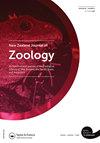Increasing the capture rates of brushtail possums in Victor #1 leg-hold traps
IF 1.1
4区 生物学
Q3 ZOOLOGY
引用次数: 1
Abstract
ABSTRACT Leg-hold or foot-hold traps have been used in New Zealand for trapping brushtail possums (Trichosurus vulpecula) since the 1920s. In the mid-1990s, when the National Pest Control Agencies (NPCA) developed a national protocol for monitoring possums, they standardised how traps should be set, which lure to use and where to place it. These recommendations aimed to achieve standardisation (important for population monitoring), not necessarily high capture rates. Recent use of trail cameras has revealed possums eating the lure, but then walking away without stepping on the trap, suggesting that modifications to the way traps are set or lured might enable increased capture rates of possums. We compared the capture rate of four alternative trap sets (i.e. double sets, covered traps, hazed traps, enlarged trigger plates) with standard NPCA-recommended sets. None of these modified sets increased the captures rates. We then compared the capture rate of traps with the lure placed on the ground encircling the trap (including a vertical visual lure) against the NPCA-recommended method of placing the lure behind the trap. This modification resulted in a 33% increase in capture rate suggesting modifications to the luring method can increase capture rates and make ground-based possum control more effective.提高Victor 1号腿夹陷阱中刷尾负鼠的捕获率
摘要自20世纪20年代以来,新西兰就开始使用腿夹或脚夹诱捕器来诱捕刷尾负鼠(Trichosurus vulpecula)。20世纪90年代中期,当国家害虫控制机构(NPCA)制定了一项监测负鼠的国家协议时,他们标准化了陷阱的设置方式、使用诱惑以及放置地点。这些建议旨在实现标准化(对种群监测很重要),而不一定是高捕获率。最近使用的追踪相机显示,负鼠正在吃掉诱饵,但随后却没有踩到陷阱就离开了,这表明,对陷阱设置或引诱方式的修改可能会提高负鼠的捕获率。我们比较了四种替代陷阱组(即双套、有盖陷阱、有雾陷阱、放大触发板)与标准NPCA推荐的陷阱组的捕获率。这些修改后的集合都没有提高捕获率。然后,我们将放置在陷阱周围地面上的诱饵(包括垂直视觉诱饵)的陷阱捕获率与NPCA建议的将诱饵放置在陷阱后面的方法进行了比较。这种修改导致捕获率提高了33%,这表明对引诱方法的修改可以提高捕获率,并使地面负鼠控制更有效。
本文章由计算机程序翻译,如有差异,请以英文原文为准。
求助全文
约1分钟内获得全文
求助全文
来源期刊
CiteScore
2.80
自引率
0.00%
发文量
20
审稿时长
>12 weeks
期刊介绍:
Aims: The diversity of the fauna of the southern continents and oceans is of worldwide interest to researchers in universities, museums, and other centres. The New Zealand Journal of Zoology plays an important role in disseminating information on field-based, experimental, and theoretical research on the zoology of the region.

 求助内容:
求助内容: 应助结果提醒方式:
应助结果提醒方式:


